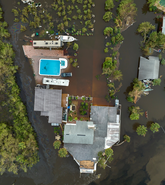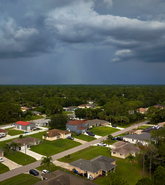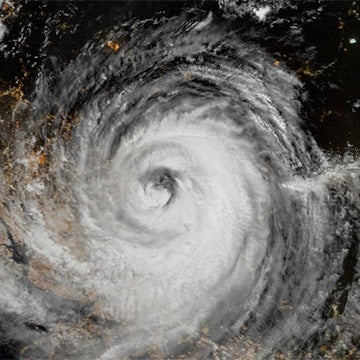Following a quiet start to the season that saw four named storms up to mid-August – or five if the unnamed January subtropical storm retrospectively analyzed by the National Hurricane Center (NHC) is included, activity then skyrocketed during the second half of August and early September with nine named storms in just four weeks.
As of mid-September, the North Atlantic basin has produced 14 named storms, five hurricanes, and three major hurricanes.
This already meets the criteria for the year to be considered at least an average season per the National Oceanographic and Atmospheric Administration (NOAA) 1991–2020 Climate Normals, with over two and a half months to go.
In terms of Accumulated Cyclone Energy (ACE), which measures the strength and duration of tropical storms and hurricanes, the season to date stands above average compared to the long-term (1991-2020) mean.
Furthermore, the basin’s Track Integrated Kinetic Energy (TIKE), a measure related to the size, strength, and destructive potential of storms, is just above average at 3,715 Terajoules (TJ) versus the 2002–22 year-to-date average of 3,622 TJ.
Both ACE and TIKE have been primarily driven by Hurricanes Idalia (see below) and Lee, which attained Category 5 major hurricane status on September 8 over the open waters of the western North Atlantic.
Hurricane Idalia
The most impactful of these storms was Idalia, which made landfall as a Category 3 major hurricane in the Big Bend region of Florida on August 30.
Idalia was the first major hurricane to make landfall in Florida's Big Bend region since recordkeeping began in 1842.
It brought catastrophic storm surge and destructive hurricane-force winds to much of northwest Florida, in particular the Big Bend region, alongside heavy rainfall, and strong winds across Georgia.
Idalia caused widespread and significant damage to properties and businesses near landfall and inland, and at its peak, more than 500,000 power outages were reported across Florida and Georgia. Moody’s RMS estimates private market insured losses from Idalia are expected to be between $US 3–5 billion.
So, with activity outpacing the forecast, what might the rest of September, October, and November have in store?
ENSO Versus SSTs: Tug of War Continues
In our Moody’s RMS Northern Hemisphere Tropical Cyclone Outlook report, released to coincide with the start of the hurricane season in June, we discussed that the pre-season forecasts of a near-normal hurricane season reflected the competing and opposing influence of several key seasonal oceanic and meteorological factors.
These are primarily the El Niño-Southern Oscillation (ENSO) and sea surface temperatures (SSTs) in the tropical North Atlantic.
The development of El Niño conditions in the tropical Pacific Ocean would typically result in below-average tropical activity in the North Atlantic Basin, owing to increased wind shear that suppresses tropical activity.
But this was in opposition to record-breaking SSTs and the West African Monsoon season in the North Atlantic and West Africa, which would typically enhance tropical activity by providing increased energy and moisture to the environment.
These factors – one that suppresses storm development and other factors that fuel it – resulted in a pre-season forecast for a near-normal season, albeit with greater than normal uncertainty given the season could tip either way if one factor were to exhibit a greater influence over the season.
So, how have conditions evolved since these initial forecasts were made? We now know that the North Atlantic and West Africa have been winning this tug-of-war battle.
Sea surface temperatures in the North Atlantic remain at record levels, with temperature anomalies in the tropical North Atlantic well above what would be expected during a typical hyperactive hurricane season.
Despite NOAA declaring that El Niño conditions were present in early June, there has yet to be a significant atmospheric response.
This was best summarized by Australia’s Bureau of Meteorology's latest ENSO update:
“Sea surface temperatures (SSTs) in the tropical Pacific are exceeding El Niño thresholds, with climate models indicating this is likely to continue at least through to the end of the year. In the atmosphere, however, wind, cloud, and broad-scale pressure patterns mostly continue to reflect neutral ENSO conditions. This means the Pacific Ocean and atmosphere have yet to become fully coupled, as occurs during El Niño events.”
The lack of coupling between the ocean and atmosphere in the Pacific thus far is consequential for hurricane development in the North Atlantic.
Vertical wind shear, a key inhibitor of hurricane development, is running at near-normal levels across much of the North Atlantic main development region.
In conclusion, ENSO has yet to make its mark on this season. That has meant that activity in the North Atlantic has been, for the most part, determined and moderated by local conditions.
A More Active Season than Previously Forecast
The hint that the North Atlantic basin would shift gears into a more active phase came in early August when updated seasonal forecasts were released from NOAA, Colorado State University, Tropical Storm Risk, the U.K. Met Office, the European Centre for Medium-Range Weather Forecasts, AccuWeather, and the Weather Channel.
These all pointed more toward a more active season than initially forecast back in June.
NOAA’s updated forecast then called for 14 to 21 named storms, six to 11 hurricanes, and two to five major hurricanes. These expected ranges were centered above the 1991-2020 seasonal averages of 14 named storms, seven hurricanes, and three major hurricanes.
As mentioned before, the basin has already reached the lower ends of these ranges with two and a half months to go.
The key factors driving those updated forecasts were the atypically favorable upper-level wind patterns across the North Atlantic given the current state of El Niño — a tell-tale sign that this year’s El Niño is one that will take time to become established and influence weather patterns in the North Atlantic — combined with the ongoing record-warm sea surface temperatures in the North Atlantic and monsoon activity over West Africa.
These conditions helped fuel the formation and development of nine named storms between mid-August and mid-September and could possibly continue to produce an active basin through the remainder of September and into early October.
What does this mean for North Atlantic hurricane activity until the end of the season?
No two El Niño are the same, they come in various flavors and appearances, but with El Niño set to continue to strengthen in the equatorial Pacific through the remainder of this year, it’s probably only a matter of time before broader-scale patterns become more El Niño-like and conditions become increasingly unfavorable.
But the key question is, when? Will the El Niño occur in time to silence the remaining peak weeks of the North Atlantic hurricane season, or might budding tropical systems emerging from West Africa and take advantage of the record-warm temperatures while they have a chance?
A Trusted Partner
Regardless of the number of storms that develop between now and the end of the season, it takes just one major event to turn a season – as we saw with Hurricane Ian last year.
As a trusted partner, Moody’s RMS is ready to support clients and inform critical business processes and decisions with reliable information and analytics during the year’s most challenging events, including data and more comprehensive analytics supplied to our cloud-native applications.
For instance, the ExposureIQ™ application on Moody’s RMS Intelligent Risk Platform™ now puts Moody’s RMS Event Response and Moody’s RMS HWind insights in the hands of our clients like never before, with around-the-clock automated updates every few hours.
The Moody’s RMS Event Response team is ensuring Moody’s RMS clients are well informed of global tropical cyclone activity with regular updates for clients on the Support Center.
Follow Moody’s RMS social media channels on Twitter and LinkedIn for updates.










